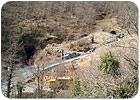
The use of slate from Liguria, Italy, dates back at least 2,000 years - as evidenced by the discovery of ancient tombstones using this material. Today, the “La Vera Lavagna” consortium (literally translated to mean “The true blackboard”) quarries slate in two areas of Liguria - one near San Remo and one near Portofino. Once the material is extracted, it is processed into a vast collection of finished products by companies such as L.E.A.N.I. Slate-Garbarino & Cueno - for both residential and commercial applications.
The quarries for slate (ardesia in Italian) operate underground, and the extraction sites tunnel directly into the mountainside. Large-scale Fantini chainsaws are used to make cuts in the quarry face, and the front loaders are used to pull blocks from the quarry. The shape and size of the block depends on the natural layers of the stone deposit. The larger blocks are around 8 x 5 x 5 feet in size, while the smaller blocks (primarily used for roofing slate) are around 6.5 x 3 ½ feet in size, with varying thicknesses.
Following the classic tradition of slate processing, tiles are split by hand. This process relies heavily on the experience and skill of the worker, who finds the natural split in the stone before striking it with a hammer and chisel. Tile sizes include 1 x 1, 1 x 2 and 1 x 3 feet, among other dimensions.
The slate tiles can receive a variety of finishes, including natural cleft, honed, brushed and sandblasted, and combinations of the different surface finishes can create a signature look for a space.
Slate from the region has also been utilized as wall cladding as well as countertops and other architectural elements. Additionally, a line of intricately shaped sinks is also made from the region’s slate, contributing to both traditional and modern design motifs.
Production stands at approximately 55,000 square feet of tiles and 55,000 square feet of slab products per month, in addition to architectural work, and a total of 80 workers are employed in all.